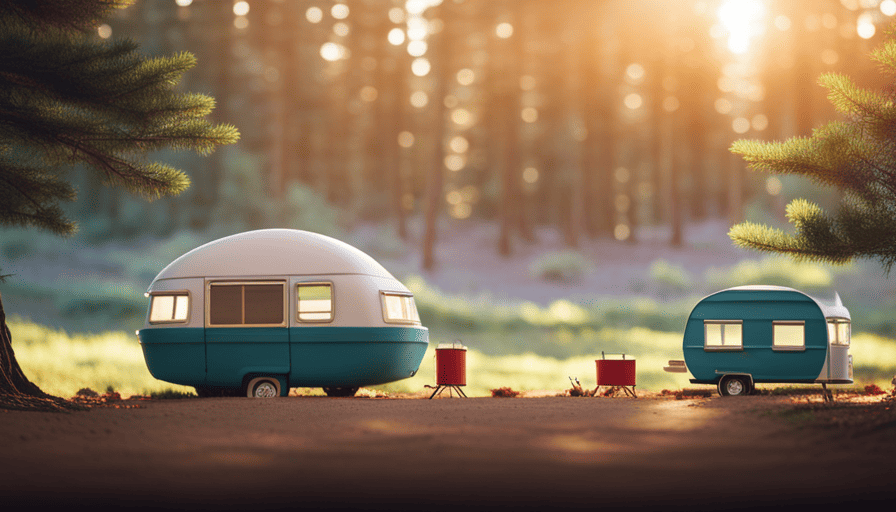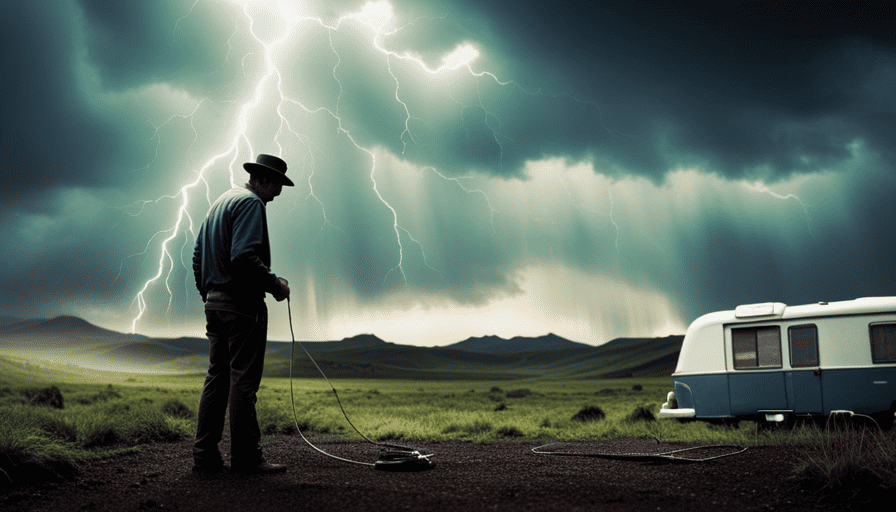Picture yourself on an expansive highway, with the sun beaming on your reliable truck as it smoothly tows a Fifth Wheel Camper. As seasoned voyagers, we understand that managing a Fifth Wheel Camper tow involves meticulous planning and careful implementation.
It’s not just about hooking up and hitting the road; it’s about understanding your vehicle’s towing capacity, choosing the right hitch, and ensuring the safety of everyone on the road.
In this article, we will guide you through the step-by-step process of towing a Fifth Wheel Camper with ease and confidence. From attaching the hitch to your truck to adjusting your driving techniques, we will provide you with detailed instructions and expert tips that will make your towing experience a breeze.
So, let’s get started and embark on the journey of towing a Fifth Wheel Camper like seasoned adventurers!
Key Takeaways
- Understanding your vehicle’s towing capacity is crucial.
- Choose a vehicle with a towing capacity that exceeds the weight of your camper.
- Proper hitch installation is essential for a safe towing experience.
- Regularly inspect and maintain towing equipment for a trouble-free journey.
Understand Your Vehicle’s Towing Capacity
Before you can hit the road with your fifth wheel camper, it’s crucial to know your vehicle’s towing capacity. Understanding the towing capacity of your vehicle is essential to ensure a safe and smooth towing experience.
This capacity refers to the maximum weight that your vehicle can safely tow without causing any damage to its engine, transmission, or other components.
To determine your vehicle’s towing capacity, you can refer to the owner’s manual or contact the manufacturer. It is important to note that the towing capacity can vary depending on the model, engine type, and additional equipment your vehicle may have.
It’s always better to choose a vehicle with a towing capacity that exceeds the weight of your fifth wheel camper to allow for a margin of safety.
Choosing the right vehicle for towing your fifth wheel camper is crucial for a hassle-free journey. Consider factors such as the vehicle’s engine power, torque, and suspension capabilities. Additionally, make sure to check if your vehicle has the necessary features like a towing package and trailer brake controller.
Now that you have a good understanding of your vehicle’s towing capacity and have chosen the right vehicle, let’s move on to the next step – choosing the right hitch.
Choose the Right Hitch
First things first, you gotta pick the hitch that’s gonna make your ride with that majestic home-on-wheels a breeze. When it comes to towing a fifth wheel camper, the hitch is the crucial connection between your truck and the camper. Proper hitch installation is essential for a safe and smooth towing experience.
To choose the right hitch, you need to consider hitch compatibility with your truck. It’s vital to ensure that the hitch you select is designed to work with your truck’s towing capacity and hitch receiver. Check the weight ratings of both your truck and the hitch to ensure they match up. Additionally, consider the type of hitch that will best suit your needs, such as a fifth wheel hitch or a gooseneck hitch.
Once you have chosen the right hitch, it’s time to attach it to your truck. This step involves securely mounting the hitch onto the bed of your truck and properly connecting it to the hitch receiver. Following the manufacturer’s instructions is crucial to ensure a safe and secure attachment.
With the hitch properly installed and attached to your truck, you’ll be ready for the next step: attaching the hitch to your camper.
Attach the Hitch to Your Truck
Now that you’ve carefully selected the perfect hitch, it’s time to securely attach it to your trusty truck. Before you begin, it’s crucial to ensure that your truck meets the necessary specifications to safely tow a fifth wheel camper. Check the owner’s manual or consult with a professional to confirm the towing capacity, payload capacity, and hitch weight limit for your specific make and model.
To start the hitch installation process, gather all the necessary tools and equipment, including a torque wrench, socket set, and safety goggles. Position the hitch assembly on the truck bed, aligning it with the pre-drilled holes. Make sure the hitch is centered and level before tightening the bolts to the manufacturer’s recommended torque specifications.
Double-check all the connections and ensure that the hitch is properly secured to the truck frame.
Once the hitch is securely attached, you can move on to connecting the fifth wheel to the hitch. This will be covered in the subsequent section, where we will guide you through the process step by step. Remember, properly installing the hitch is crucial for safe and successful towing of your fifth wheel camper.
Connect the Fifth Wheel to the Hitch
Once you’ve securely fastened the hitch to your truck, it’s time to bring these two mighty forces together in a glorious union of towing prowess. Connecting the fifth wheel securely to the hitch is crucial for a safe and smooth journey. Here are four key steps to ensure proper alignment and a secure connection:
-
Position your truck directly in front of the fifth wheel, making sure it’s level and on solid ground.
-
Lower the tailgate of your truck and slowly back up until the kingpin on the fifth wheel aligns with the hitch on your truck.
-
Once aligned, engage the truck’s parking brake and carefully lower the trailer onto the hitch.
-
Double-check that the kingpin is fully seated in the hitch by pulling up on the trailer to make sure it doesn’t come loose.
By following these steps, you can be confident that your fifth wheel is securely connected to the hitch, ready for the road ahead.
Now that the connection is established, it’s essential to check your brake and signal lights to ensure they’re functioning properly. This will further enhance the safety of your towing experience.
Check Your Brake and Signal Lights
Ensuring the functionality of your brake and signal lights is crucial for a safe and worry-free journey on the road. Before setting off with your fifth wheel camper, it’s important to check that all your lights are working properly. This includes both the brake lights and the signal lights.
To begin, start by testing the signal lights. This can be done by having someone stand behind the camper while you activate each turn signal. Make sure to check both the left and right signals, as well as the hazard lights. If any of the lights aren’t functioning, you may need to troubleshoot the wiring or replace the bulbs.
Next, move on to the brake lights. Have someone press the brake pedal while you observe the rear of the camper. Both brake lights should illuminate brightly. If one or both lights are dim or not working at all, you may need to perform some maintenance, such as replacing the bulbs or checking the wiring connections.
Once you’ve confirmed that all your brake and signal lights are in proper working order, you can proceed to the next section about practicing maneuvering and turning. Remember, ensuring the functionality of your lights is essential for your safety and the safety of others on the road.
Practice Maneuvering and Turning
Practice maneuvering and turning can be challenging, but did you know that 23% of accidents involving recreational vehicles occur during turns? It’s crucial to have a good understanding of maneuvering techniques and turning safety when towing a fifth wheel camper.
Here are some key tips to help you navigate those tight corners and turns with ease:
-
Take wider turns: When turning, make sure to swing out wide to give your trailer enough room to follow the same path. This’ll prevent your camper from hitting curbs or obstacles.
-
Use your mirrors: Constantly check your mirrors to ensure your trailer is tracking correctly. Adjust them properly so you have a clear view of both sides and the rear of your camper.
-
Slow down before turns: Reduce your speed before entering a turn to maintain better control. This’ll help prevent your trailer from swaying or tipping over.
-
Watch out for obstacles: Be aware of low-hanging branches, sharp turns, or narrow roads that may pose a challenge for your fifth wheel camper. Plan your route accordingly to avoid any potential hazards.
By practicing these maneuvering techniques and turning safety tips, you can significantly reduce the risk of accidents while towing your fifth wheel camper. Now, let’s transition into the next section and discuss how to adjust your driving techniques for a smoother towing experience.
Adjust Your Driving Techniques
After spending some time practicing maneuvering and turning with your fifth wheel camper, you should feel more confident behind the wheel. Now it’s time to adjust your driving techniques to ensure a smooth and safe towing experience.
One of the key aspects to consider when towing a fifth wheel camper is adjusting your speed. It’s important to remember that you’re hauling a significant amount of weight, so you’ll need to give yourself more time to slow down and come to a complete stop. Maintaining a lower speed will also help you maintain control over your vehicle and the camper.
When it comes to turns, it’s crucial to take them slowly and wide. Turning too sharply can cause the camper to swing out, potentially leading to an accident. By making wider turns and giving yourself ample space, you can mitigate this risk and keep everything in control.
As you drive, pay close attention to the behavior of your camper. If you notice any sway or instability, adjust your driving techniques accordingly. This might involve adjusting your speed, redistributing weight, or even making slight modifications to your hitch setup.
Now that you have a better understanding of how to adjust your driving techniques, let’s move on to the next important aspect: being mindful of weight distribution.
Be Mindful of Weight Distribution
Maintaining proper weight distribution is crucial for a smooth and safe towing experience with your RV. When it comes to towing a fifth wheel camper, here are some weight distribution tips and safe towing practices to keep in mind:
-
Ensure that the majority of the weight is distributed over the axles of both the tow vehicle and the camper. This helps maintain stability and prevents excessive swaying.
-
Use a weight distribution hitch, which helps evenly distribute the weight between the tow vehicle and the camper. This reduces strain on the rear axle of the tow vehicle and improves overall towing performance.
-
Avoid overloading the camper. Be mindful of the weight limits specified by the manufacturer and distribute the cargo evenly throughout the camper.
-
Regularly check the tire pressure of both the tow vehicle and the camper. Properly inflated tires contribute to better weight distribution and enhance overall towing safety.
-
Consider installing sway control devices, such as sway bars or electronic stabilizers. These help minimize sway caused by crosswinds or passing vehicles.
Maintaining proper weight distribution and implementing safe towing practices are essential for a successful journey with your fifth wheel camper. With these tips in mind, you’ll be well-prepared to tackle the next step: planning ahead for parking and campsite setup.
Plan Ahead for Parking and Campsite Setup
Before embarking on your journey with your RV, make sure to carefully plan and prepare for the parking and setup of your campsite, just like a conductor orchestrating a symphony to ensure a harmonious and enjoyable experience.
Properly parking your fifth wheel camper is crucial for safety and convenience. When choosing a campsite, consider the size of your camper and ensure that the site can accommodate it. Look for level ground to park on, as this will make setup much easier. It’s also important to check for any obstacles or low-hanging branches that could hinder parking or cause damage to your camper.
When you arrive at your campsite, take your time to properly position your fifth wheel camper. Use your spotter to guide you into the desired location, making sure to leave enough space for your slide-outs and awnings. Use leveling blocks or stabilizing jacks to ensure your camper is level and stable. This will not only make your stay more comfortable but will also prevent any damage to your camper’s structure.
Once your camper is parked, it’s time to set up your campsite. Begin by connecting your utilities, such as water and electricity. Extend your slide-outs and awnings, if applicable, and secure them properly. Set up your outdoor furniture, grill, and any other amenities you may have brought along. Finally, don’t forget to check your surroundings for any potential hazards or inconveniences, such as an uneven terrain or proximity to other campers.
By following these parking tips and properly setting up your campsite, you’ll be well on your way to a relaxing and enjoyable RV adventure. Regularly inspecting and maintaining your towing equipment is the next step in ensuring a smooth journey.
Regularly Inspect and Maintain Your Towing Equipment
Regularly checking and maintaining your towing gear is essential for a smooth and trouble-free RV journey. Before hitting the road, it’s crucial to inspect your towing equipment to ensure it’s properly functioning.
Start by examining the hitch and coupler for any signs of wear or damage. Make sure they’re securely fastened and lubricated. Check the safety chains to ensure they’re in good condition and properly attached.
Inspect the brake controller and wiring to ensure they’re functioning correctly. It’s also important to inspect the tires, including the spare, for any signs of wear or damage. Proper tire pressure and tread depth are crucial for safe towing.
Additionally, regularly maintaining your towing equipment is key to its longevity and reliability. Clean and lubricate the hitch and coupler regularly to prevent rust and ensure smooth operation. Grease the wheel bearings as recommended by the manufacturer to prevent overheating and potential breakdowns.
Keep an eye on the brake pads and replace them if they’re worn down. Lastly, regularly inspect the suspension and suspension components for any signs of wear or damage. By regularly inspecting and maintaining your towing equipment, you can enjoy a worry-free RV journey.
Frequently Asked Questions
How much weight can my specific vehicle safely tow?
To determine the safe towing capacity of our specific vehicle, we need to investigate its manufacturer specifications and consult the owner’s manual. It’s important to consider factors such as the vehicle’s engine power, transmission, suspension, and braking system. Additionally, weight distribution is crucial for safe towing, ensuring that the load is properly balanced and doesn’t exceed the vehicle’s maximum capacity. By adhering to these guidelines, we can confidently determine our vehicle’s towing capabilities.
What type of hitch is best for towing a fifth wheel camper?
When it comes to towing a fifth wheel camper, the type of hitch you choose is crucial. There are several hitch options available, each with their own benefits and considerations.
Factors such as towing capacity, trailer weight, and compatibility with your vehicle should be taken into account. It’s essential to select a hitch that can handle the weight of your camper and ensure a secure and stable connection between your vehicle and the trailer.
How do I properly connect the fifth wheel to the hitch?
To properly connect a fifth wheel to the hitch, it’s crucial to follow the proper hitching technique. One common mistake to avoid is not ensuring that the hitch and the kingpin are properly aligned. This can lead to a dangerous situation while on the road.
Another mistake is not double-checking that the hitch is securely locked in place. This can cause the fifth wheel to become detached while driving.
Taking the time to carefully connect the fifth wheel to the hitch can prevent accidents and make for a smooth towing experience.
Is it necessary to check the brake and signal lights on the camper before towing?
Yes, it’s absolutely necessary to check the brake and signal lights on the camper before towing. Ensuring that these lights are in proper working order is crucial for the safety of both yourself and other drivers on the road. To troubleshoot any issues, start by checking the fuses and bulbs.
Additionally, regularly checking the tire pressure on the camper is important to ensure optimal performance and prevent any potential tire blowouts while towing.
How often should I inspect and maintain my towing equipment?
We can’t stress enough how crucial it is to regularly inspect and maintain your towing equipment. It’s not just a once-in-a-blue-moon kind of thing; it requires consistent attention.
Inspecting your equipment should become as habitual as your morning coffee. We recommend conducting a thorough inspection at least once a month, but if you’re a frequent traveler, bi-weekly checks may be necessary.
Create a maintenance checklist that includes items like checking for wear and tear, ensuring proper lubrication, and testing all connections for optimal safety.
Are the Steps to Tow a Fifth Wheel Camper the Same as Towing a 5th Wheel Camper?
When it comes to towing a fifth wheel camper, the steps involved are the same whether you are towing a 5th wheel camper or a fifth wheel camper. Both require properly connecting the hitch, adjusting weight distribution, and ensuring proper braking and signaling. Safety precautions remain essential for a smooth towing experience.
Conclusion
To wrap things up, towing a fifth wheel camper requires careful attention to detail and adherence to safety guidelines. Our experience has taught us that understanding your vehicle’s towing capacity is crucial, as is choosing the right hitch and properly attaching it to your truck.
By checking your brake and signal lights, adjusting your driving techniques, and being mindful of weight distribution, you can ensure a smooth and enjoyable towing experience. Lastly, don’t forget to regularly inspect and maintain your towing equipment to keep everything in top shape.
Happy towing!











